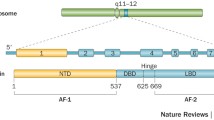Abstract
In 1989 the unanticipated agonist effect of antiandrogens on LNCaP prostate cancer cells was detected. A “flutamide withdrawal syndrome” was first described by Kelly and Scher [15], who reported a decrease in serum prostate-specific antigen (PSA) levels after the removal of flutamide from the treatment regimen. In the last few years the paradoxical response to antiandrogens has also been reported for bicalutamide, chlormadinone acetate and others. Therefore the name of the syndrome has changed to \ldantiandrogen withdrawal syndrome.\rd Several reasons such as mutations in the androgen receptor or a direct stimulatory effect of the antiandrogen for this effect have been discussed, but the exact molecular mechanism remains unclear. However, in patients with hormonally relapsed prostate cancer, a trial of \ldwithdrawal therapy\rd is required prior to the initiation of toxic therapies.
Similar content being viewed by others
References
Akakura K, Akimoto S, Ohki T, Shimazaki J (1995) Antiandrogen withdrawal syndrome in prostate cancer after treatment with steroidal antiandrogen chlormadinone acetate. Urology 45:700
Belani CP, Pearl P, Whitley NO, Aisner J (1989) Tamoxifen withdrawal response. Arch Intern Med 149:449
Bissada NK, Kaczmarek AT (1995) Complete remission of hormone refractory adenocarcinoma of the prostate in response to withdrawal of diethylstilbestrol. J Urol 153:1944
Boring CC, Squires TS, Tong T (1992) Cancer statistics. CA Cancer J Clin 42:19
Bruchovsky N, Goldenberg SL, Rennie PS, Gleave M (1995) Theoretische Überlegungen und erste klinische Ergebnisse mit intermittierender Hormonbehandlung bei Patienten mit einem fortgeschrittenen Prostatakarzinom. Urologe A 34:389
Culig Z, Hobisch A, Cronauer MV, Cato AC, Hittmair A, Radmayr C, Eberle J, Bartsch G, Klocker H (1993) Mutant androgen receptor detected in an advanced-stage prostatic carcinoma is activated by adrenal androgens and progesterone. Mol Endrocrinol 7:1541
Cusan L, Gomez JL, Dupont A, Diamond P, Lemay M, Moore S, Labrie F (1994) Metastatic prostate cancer pulmonary nodules: beneficial effects of combination therapy and subsequent withdrawal of flutamide. Prostate 24:257
Dawson NA, McLeod DG (1995) Dramatic prostate specific antigen decrease in response to discontinuation of megestrol acetate in advanced prostate cancer: expansion of the antiandrogen withdrawal syndrome. J Urol 153:1946
Dupont A, Gomez JL, Cusan L, Koutsilieris M, Labrie F (1993) Response to flutamide withdrawal in advanced prostate cancer in progression under combination therapy. J Urol 150:908
Evans BAJ, Harper ME, Daniells CE, Watts CE, Matenhelia S, Green J, Griffiths K (1996) Low incidence of androgen receptor gene mutations in human prostatic tumors using single strand conformation polymorphism analysis. Prostate 28:162
Figg WD, Sartor O, Cooper MR, Thibault A, Bergan RC, Dawson N, Reed E, Myers CE (1995) Prostate specific antigen decline following the discontinuation of flutamide in patients with stage D2 prostate cancer. Am J Med 98:412
Gaddipati JP, McLeod DG, Heidenberg HB, Sesterhenn IA, Finger MJ, Moul JW, Srivastava S (1994) Frequent detection of codon 877 mutations in the androgen receptor gene in advanced prostate cancers. Cancer Res 54:2861
Herrada J, Dieringer P, Logothetis CJ (1996) Characterization of patients with androgen-independent prostatic carcinoma whose serum prostate specific antigen decreased following flutamide withdrawal. J Urol 155:620
Hobisch A, Culig Z, Radmayr C, Bartsch G, Klocker H, Hittmair A (1996) Androgen receptor status of lymph node metastases from prostate cancer. Prostate 28:129
Kelly WK, Scher HI (1993) Prostate specific antigen decline after antiandrogen withdrawal: The flutamide withdrawal syndrome. J Urol 149:607
Liebertz C, Kelly WK, Theodoulou M, Curley T, Dean L, Moyumdar M, Vlanis V, Scher HI (1995) High-dose Casodex for prostate cancer (PC): PSA declines in patients with flutamide withdrawal responses. Proc Am Soc Clin Onc 14 (abstract):603
Moul JW, Srivastava S, McLeod DG (1995) Molecular implications of the antiandrogen withdrawal syndrome. Semin Urol 13:157
Newmark JR, Hardy DO, Tonb DC, Carter BS, Epstein JI, Isaacs WB, Brown TR, Barrack ER (1992) Androgen receptor gene mutations in human prostate cancer. Proc Natl Acad Sci USA 89:6319
Nieh P (1995) Withdrawal phenomenon with the antiandrogen casodex. J Urol 153:1070
Sartor O, Cooper M, Weinberger M, Headlee D, Thibault A, Tompkins A, Steinberg S, Figg WD, Linehan WM, Myers CE (1994) Surprising activity of flutamide withdrawal, when combined with aminoglutethimide, in treatment of “hormonerefractory” prostate cancer. J Natl Cancer Inst 86:222
Sasagawa I, Satomi S (1990) Effect of high-dose medroxyprogesterone acetate on plasma hormone levels and pain relief in patients with advanced prostatic cancer. Br J Cancer 65:278
Scher HI, Kelly WK (1993) The flutamide withdrawal syndrome: Its impact on clinical trials in hormone-refractory prostatic cancer. J Clin Oncol 11:1566
Scher HI, Zhang ZF, Cohen L, Kelly KW (1995) Hormonally relapsed prostatic cancer: Lessons from the flutamide withdrawal syndrome. Adv Urol 8:61
Small EJ, Carroll PR (1994) Prostate-specific antigen decline after casodex withdrawal: evidence for an antiandrogen withdrawal syndrome. Urology 43:408
Suzuki H, Sato N, Watabe Y, Masai M, Seino S, Shimazaki J (1993) Androgen receptor gene mutations in human prostate cancer. J Steroid Biochem Mol Biol 46:759
Taplin ME, Bubley GJ, Shuster TD, Frantz ME, Spooner AE, Ogata GK, Keer HN, Balk SP (1995) Mutation of the androgen-receptor gene in metastatic androgen-independent prostate cancer. N Engl J Med 332:1393
Veldscholte J, Ris-Stalpers C, Kuiper GGJM, Jenster G, Berrevoets C, Claasen C, VanRooij HCJ, Trapman J, Brinkmann AO, Mulder E (1990) A mutation in the ligand binding domain of the androgen receptor of human LNCaP cells affects steroid binding characteristics and response to antiandrogens. Biochem Biophys Res Commun 173:534
Wilding G, Chen M, Gelmann EP (1989) Aberrant response in vitro of hormone responsive prostate cancer cells to antiandrogens. Prostate 14:103
Author information
Authors and Affiliations
Rights and permissions
About this article
Cite this article
Wirth, M.P., Froschermaier, S.E. The antiandrogen withdrawal syndrome. Urol. Res. 25 (Suppl 2), S67–S71 (1997). https://doi.org/10.1007/BF00941991
Received:
Accepted:
Issue Date:
DOI: https://doi.org/10.1007/BF00941991




